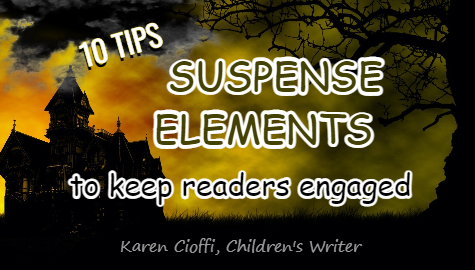Contributed by Eric Myers, Writer, Editor
Mystery novels are not the only place where you want to keep the reader hooked to your pages by adding suspense.
Here are a few tips on how to incorporate suspenseful elements and keep your readers engaged from beginning to end.
1. OPEN WITH HIGH-STAKES
Start the story by introducing a big dilemma. Show the reader what life used to be like for the main character, and how it has changed considering this challenge they are up against. Make sure to illustrate the huge consequences if the protagonist fails to resolve the problem.
Once the audience knows what is on the line and what will happen if it is not resolved, all future chapters will include suspense. Every time the protagonist takes a step closer to reaching their goal, the anticipation for a resolution intensifies.
The effects should be significant and on a grand scale (the hero trying to save the universe or an entire city, or perhaps even just one building, or even the life of a loved-one) as well as making an impact on them emotionally (if they don’t fix it, they will suffer trauma that could change them forever).
2. USE THE PROTAGONIST’S OWN ANXIETY
Given the high-stakes situation, the protagonist’s level of anxiety will vary depending on their character.
Suppose they must break certain laws in order to resolve the problem; every time someone gives them a second glance, they'll feel uneasy and worry that they are being watched or followed.
This fear can be used in narration to make even a simple stroll extraordinary as the protagonist has to overcome the uncertainty of any possible outcome.
You can use this sense of dread for your protagonist to boost suspense even if it’s just an imagined worst-case scenario.
3. INDICATE FUTURE DANGER
The term “indicate” is used because the readers should be made aware of potential peril for the protagonist, but this can be done in multiple ways.
Foreshadowing is subtler and often takes form in narration. Something that happened to the protagonist or someone else in the past could possibly happen in the future.
Foretelling, on the other hand, is more direct. Rather than imply something might happen, it states that if a certain condition (or conditions) is met, then something bad will happen to the protagonist. This warns the reader of what lies ahead.
4. LEAVE CLUES
The protagonist continued to investigate the plot, searching for answers to the little mysteries that had been planted. She had long suspected there was something more sinister going on beneath the surface, but she could never quite put her finger on it.
For example, the hero, while they explored a certain area, stumbled upon an ancient temple deep in the woods. Inside this temple was a chamber filled with artifacts that seemed too old to be from any known civilization and yet were strangely familiar. As the character began to inspect them closer, she realized that each artifact contained some kind of riddle or puzzle inscribed upon them.
Or perhaps the hero, while searching for a missing person at their last known address, instead finds evidence of heavy drug activity, or the place was ransacked, or the place was abandoned in a hurry, or the entire building was burned to the ground.
Or, if you prefer a slower burn... as the hero takes steps to solve the problem they uncover details that change the nature of the dilemma...
For Example:
The missing person was having an affair
The Villian recently lost a lot of money at a underground casino.
The daughter was adopted... and she still doesn't know.
The name a person was using is not their real name...
And so on.
Just have fun throwing new information and fun twists in each chapter.
5. ADD UNSEEN DANGER
Similar to anxiety, the protagonist is consistently on high alert. Every unfamiliar noise they hear, every unidentifiable figure on the subway, and every unexpected phone call adds to their sense of impending danger. When the hero can feel menace in the air but cannot see it directly, tension will be heightened within the scene.
This type of suspenseful atmosphere isn't sustained throughout the book; rather, it is used for moments when an extra punch of fear is needed.
6. USE OCCASIONAL CLIFFHANGERS
The way a chapter ends will affect the reader's experience – whether they decide to keep on reading or put the book down for the day.
Creating an exciting cliffhanger at the end of the chapter, when the protagonist has just discovered something, found a clue, or is facing an enemy, will make readers eager to find out what happens next.
Nonetheless, don't use this technique too much - readers will become tired of it and feel manipulated into feeling suspense and anticipation. Make sure to only use this method sparingly in the beginning and reserve the highest impactful moments of the plot for the end of each chapter.
7. GIVE THE VILLAIN OR ANTAGONIST ACCESS TO PRIVILEGED INFORMATION
To add more suspenseful elements, you can use the point of view of the antagonist or villain to tell the reader things that the protagonist is unaware of.
As an example, the antagonist might be tracking the protagonist's every move, peering into their window, or following them in their daily routine.
By utilizing this perspective, readers can discover what the enemy plans to do to the hero - adding further suspense and anticipation for what will occur next as they hope that the protagonist will prevent their adversary's endeavors from coming to fruition.
8. ADD A COUNTDOWN
This device does not have to be so literal as a ticking time bomb. It refers to any imposed time limit that must be met to avoid serious consequences.
There is a person about to run out of:
Money
Good Favor with the Bad Guy
Protection
Ammunition
Air, Food, Water
The effects of a spell
Concealment
Immunity
Time until they are caught
Don't do this in every scene... but adding a time element can really amp up the excitement level.
9. PUT STRESS ON THE CHARACTER’S RELATIONSHIPS
How will the outcome of the hero’s actions impact their relationship with:
A love interest
Their spouse
Their kids
A Boss
A Rival
Etc.
10. ALWAYS UP THE ANTE
Don’t keep the same game with the same stakes throughout the entire novel. Always be making things harder for the hero.
Have them lose time chasing a dead end. Have them feel the heat from their boss, kids, wife, competition, etc.
Have them lose a valuable resource. Have a reliable sidekick tun on them. Have them discover that new people are allies with the villain. Show the bad guy pulling ahead and he shortens the deadline.
In each new section always ask yourself, “What would make this harder for the hero and more fun for the reader?”
ABOUT THE AUTHOR
I began my professional writing career in 1993 in the ad department at the Washington Post
.
Writing has led me to some wonderful opportunities- Public Relations at the US Embassy in Moscow, Managing Editor at a national magazine, Communications Director for a worldwide church movement and even landed me on the Best-Sellers list a few times.
But that was not my first career. I started out of college as a family therapist. And I have spent time as a Methodist Pastor. I mention these other careers because I believe they are very relevant.
Becoming a good writer is not just about learning the technical aspects of the craft. It is also about overcoming doubts and fears. And answering that huge question, “Can I really do this for a living?”
And it is also being able to find the answer to a few other pressing questions like: “What do I have to say?” “Who is my audience?” “Why Should I be the one to share that message.”
Eric Myers, Entrepreneur, Writer and Speaker
Warp Speed Editing
https://www.warpspeedediting.com
Follow Eric at: https://www.facebook.com/eric.myers.336

I’m a working children’s ghostwriter, rewriter, editor, and coach. I can help turn your story into a book you’ll be proud to be the author of, one that’s publishable and marketable.
OTHER HELP I OFFER:
HOW TO WRITE A CHILDREN’S FICTION BOOK
A DIY book to help you write your own children’s book.
PICTURE BOOK AND CHAPTER BOOK COACHING
Four to ten-week coaching programs.
WRITERS ON THE MOVE PRESS.
Self-publishing help for children’s authors.
You can contact me at: kcioffiventrice@gmail.com. Or give me a call at 347—834—6700. (Please leave a message- I’ll get back to you as soon as I can.)

Writing Plot Twists into Your Story
Villain or Antagonist - Is There a Difference?
Plot and Your Story – Four Formats


